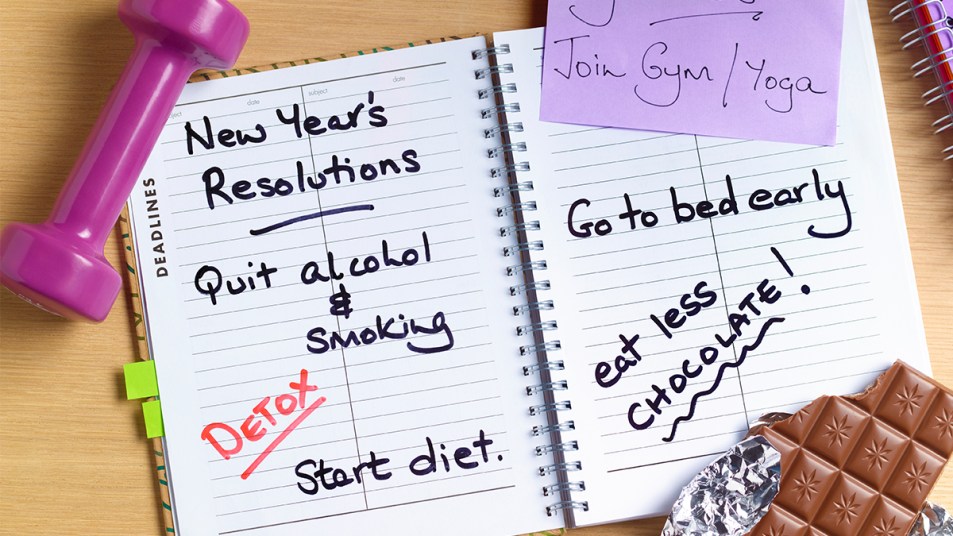5 Proven Tricks to Help You Actually Achieve Your New Year’s Resolutions
These research-backed tips are a surefire way to ensure this is your year!

Most of us set some type of goal as we hit the refresh button to begin a new year. After all, its the perfect time to get motivated to start a new healthy habit! However, some estimates say only 8% of us actually stick to our New Year’s resolutions. If you’re wondering how to keep New Year’s resolutions, keep reading: We dug into the research and talked to experts to find out the best way to ensure you reach your goals.
To eat more veggies: Read a magazine

Great news if you’re one of the 70% of us striving to eat healthier in 2024: A Brazilian research review published in the journal Nutrients suggests regularly perusing encouraging articles about health and nutrition, like the ones you read here or in our print magazine, can help you effortlessly eat up to 70% more vegetables each week. That’s because these types of stories light up an area of the brain responsible for self-control, subconsciously prodding you to make nutritious food choices.
To lose weight: Bet on yourself
If you’ve resolved to trim down, rewarding yourself with a little “fun money” each time you meet a weight loss milestone can help you shed weight. And for even better results, start a diet pool with friends. Mayo Clinic scientists found that women were twice as likely to stick with a diet (and shed four times more weight!) when they joined a diet pool and got paid $20 each time they lost 4 pounds in a month. To do: Ask each person to chip in $10, then have those who reach a set goal by a set time share the prize.
To worry less: Try ‘balloon breathing’

Practicing taking slow, deep belly breaths (about 4 per minute) will help you stay calmer, more clear-headed and more content in the new year, no matter how chaotic life gets, a recent British study suggests. Turns out this kind of breathing stimulates the vagus nerve, which sends “stay calm” messages to the brain. To do: Place your hand on your abdomen and slowly inhale, focusing on the sensation of your belly expanding as if it were a balloon inflating. Next, feel your belly slowly fall, like a balloon deflating, as you exhale. Continue for 3 minutes; practice twice daily.
To quit smoking: Inhale this scent
At least 65% of folks who smoke really want to quit, and black pepper could be the key to kicking the habit. Turkish investigators say taking three very slow, deep sniffs of black pepper helps calm the craving center in the brain in as little as 60 seconds. Plus, it triggers the same throat and chest sensations that nicotine does. And that chases away the urge to smoke (and the edginess and anxiety that cravings so often trigger) for up to one hour per sniff. Looking for an on-the-go option? Black pepper essential oil quashes cravings as effectively as the ground spice!
And Cindy Geyer, MD, a functional medicine physician at The UltraWellness Center in Lenox, Massachusetts, offers up a few more tips. “I advise trying a mindfulness app geared specifically to smoking cessation, like Craving To Quit.” The app, which was developed by Yale University scientists, offers a three-week program that includes videos, animations and an online support group to help users quit smoking. And it works: In a Yale study of the app, 36% of users kicked the habit in one month, and 31% were still smoke-free three months later. Another study at Brown University found that smokers who used a mindfulness app smoked an average of 11 fewer cigarettes per day after a month. Even better, some users had quit smoking completely. This approach works by reducing activity in the area of the brain that triggers cravings.
For a low-tech way to get the benefits of these apps, Dr. Geyer suggests using the two-minute STOP mindfulness method the next time a craving hits. To do: Stop what you’re doing. Take a deep breath. Observe your environment and find something to be grateful for. Finally, Proceed with something that will help you in the moment, like taking a coffee break or calling a friend.
To get more sleep: Enjoy a bedtime sip
Regularly getting a great night’s sleep will help you stay clear-headed, energized and happy. Yet many of us just aren’t sleepy at bedtime, because our brains are still go-go-go, and that neural activity blocks release of sleep-inducing melatonin. Thankfully, research out of Thailand reveals that sipping 6 oz. of pineapple juice in the evening can increase blood levels of sleep-inducing melatonin by 266%, doubling your ability to drift off with ease. Turns out this tropical treat brims with easily absorbed melatonin. (You can also get the perks snacking on a cup of fresh, frozen or canned pineapple!)
Another way to ensure you drift off: Take a bath. “A warm bath 90 minutes before bed may help you fall asleep faster,” reveals neurologist Brandon R. Peters, MD, author of Sleep Through Insomnia. “Your temperature dips afterward, easing you into sleep.”
This content is not a substitute for professional medical advice or diagnosis. Always consult your physician before pursuing any treatment plan.
For more on reaching your goals and navigating the year ahead, keep reading!
How to Eat More Veggies: These Genius Tricks Make It So Easy to Get All the Health Benefits
Your 2024 Yearly Horoscope: What’s in Store for Your Sign in Love, Work and Wellness
What Is Habit Pairing and Stacking? Answer: The Way To Make Your Goals Stick
Top 10 Diets of 2023: How They’re Helping Women Lose 100+ Pounds & How They Can Work for You!


















